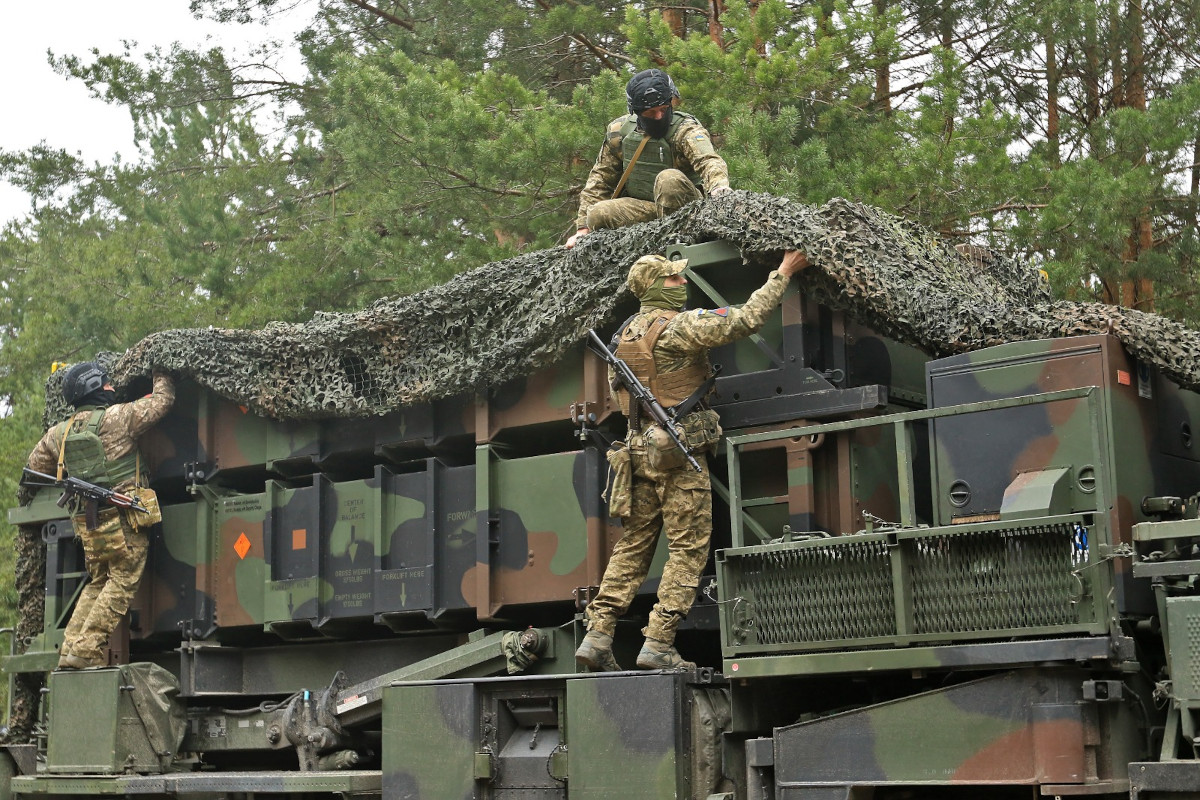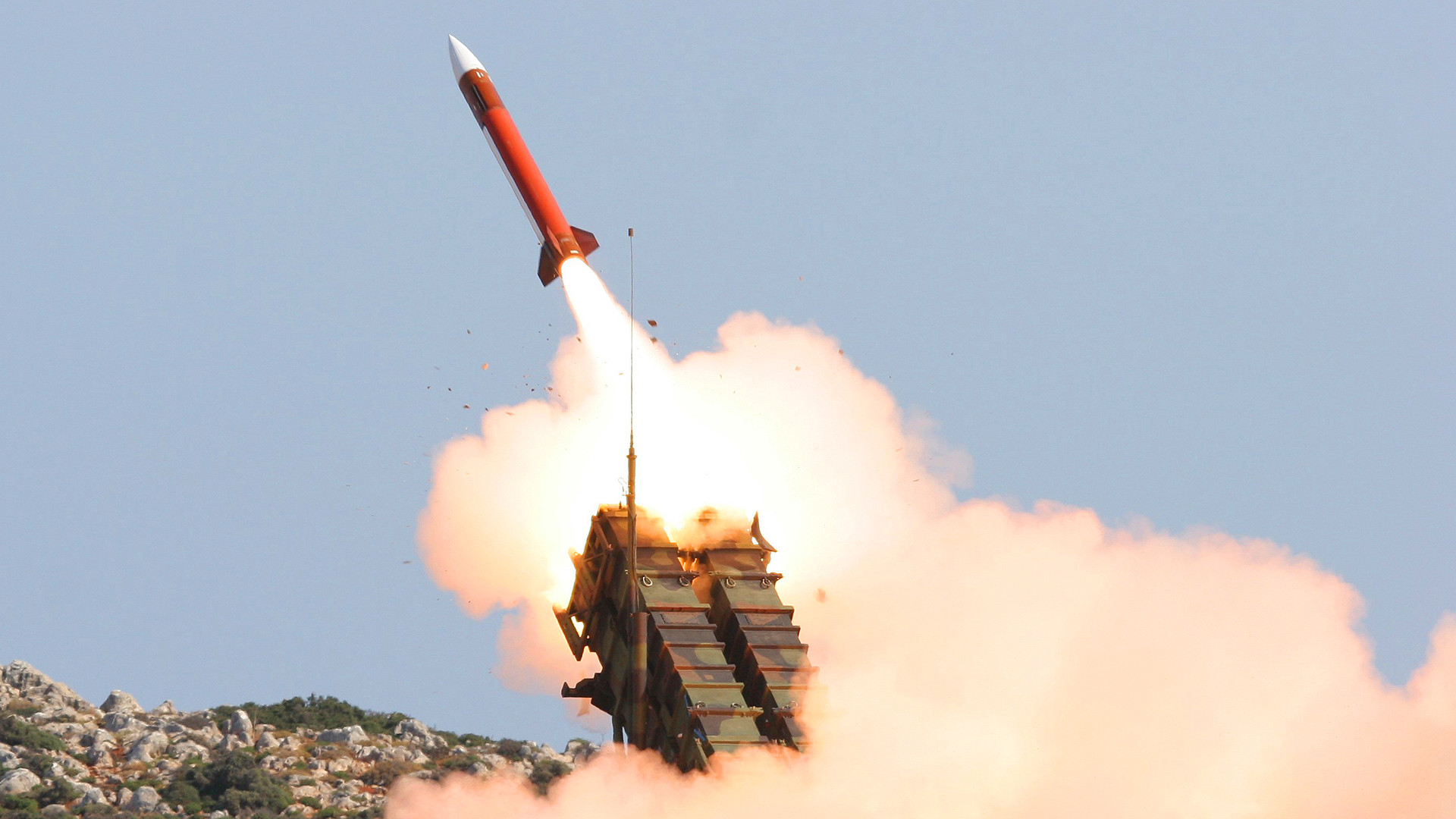The U.S. Army has disclosed the different interceptors, five in total, it has provided to Ukraine to go with its Patriot air defense systems. This includes what appears to be the first official confirmation that the most modern and highly capable PAC-3 MSE variant has been provided to Ukraine’s air defense forces. Overall, the Patriot has been praised by Ukrainian officials as one of the most effective pieces of Western-supplied military equipment the country has received to date.
The different types of U.S.-supplied missiles to arm the Ukrainian Patriot batteries were confirmed earlier this week in a briefing that U.S. Army Program Executive Office Missiles and Space (PEO MS) gave at the Space and Integrated Air, Missile Defense (SMD) Symposium, now taking place in Huntsville, Alabama. Aviation Week‘s Pentagon Editor Brian Everstine shared a picture of the relevant slide on Twitter. In addition to Patriot, PEO MS, specifically, has also overseen direct transfers and/or helped facilitate sales of High Mobility Artillery Rocket Systems (HIMARS) and precision-guided rockets for them to fire, Javelin and TOW anti-tank missiles, Avenger air defense vehicles, Stinger shoulder-fired surface-to-air missiles (also known as man-portable air defense systems, or MANPADS), and Switchblade 300 loitering munitions to Ukraine’s military.
To date, the Ukrainian armed forces have received at least two complete Patriot systems, one from the United States and one provided cooperatively by Germany and the Netherlands. Germany recently announced that it supplied two additional Patriot launchers to Ukraine.
A typical complete U.S. Army Patriot battery consists of up to eight trailer-mounted launchers, an AN/MPQ-65 multifunction phased array radar, all linked to an Engagement Control Station (ECS), along with other communications and support equipment.

The slide from the PEO Missiles and Space briefing shows that Ukraine has already received Guidance Enhanced Missile (GEM), GEM-Cruise (GEM-C), and GEM-Tactical (GEM-T) versions of the PAC-2 missile, plus the Cost Reduction Initiative (CRI) and Missile Segment Enhancement (MSE) variants of the PAC-3, for use with its Patriot systems.
Prior to this, there had been visual confirmation that the PAC-3 CRI was among the interceptors Ukraine was using with its Patriot systems. Patriot systems in Ukraine had also been observed loaded with older interceptors, which come in very different launch canisters from PAC-3 types, which were believed to be PAC-2 types.


The original Patriot interceptor, designated the MIM-104A, was introduced with the rest of the initial system in 1981. This was followed by the MIM-104B, also known as the PAC-1 or the Standoff Jammer Countermeasures (SOJC) variant, in the late 1980s. As the SOJC moniker implies, the B version featured guidance system upgrades that made it more resistant to enemy electronic warfare.
The MIM-104C, also known as the PAC-2, was also introduced in the late 1980s and featured further guidance system improvements and a new warhead, all designed to give it a formalized anti-ballistic missile capability. U.S. Army Patriot systems, using a mix of PAC-1 and PAC-2 interceptors, infamously had an at best mixed track record against Iraqi Scud short-range ballistic missiles during the Gulf War in 1991.

The first of the PAC-2 GEM-series missiles, the MIM-104D, the oldest Patriot interceptors the U.S. Army says it has supplied to Ukraine, first entered served in the mid-1990s. These feature an improved seeker designed to help better engage smaller targets or ones otherwise with smaller radar cross-sections, as well as changes to the warhead’s fuze to tackle faster-moving ballistic missiles.
Per the Army, Ukrainian forces have also received both subvariants of the follow-on MIM-104E, which are also known collectively as GEM+ missiles. The E variant features a completely new front section with upgrades that give both subtypes improved accuracy and overall performance. These interceptors feature various reliability updates, as well.
The existence of the GEM-C and GEM-T subvariants is a byproduct of the upgrading of older MIM-104C and D missiles to the E configuration. Converted MIM-104Ds were given additional upgrades to improve performance against tactical ballistic missiles, hence the GEM-T moniker. The MIM-104Cs brought up to the E standard are better optimized against air-breathing threats like cruise missiles, which is why they are referred to as GEM-Cs.

Raytheon still produces the GEM-T subvariant today and the design has received further enhancements over the years.
The PAC-3 series, the baseline version of which first entered U.S. Army service in 2001, represented a much more radical departure from earlier Patriot interceptors. All PAC-3 types, which Lockheed Martin produces and are sometimes referred to collectively as MIM-104Fs, have a totally different configuration that is svelter than their predecessors.

The size and shape of the PAC-3s are by-products of them being ostensibly so-called “hit-to-kill” interceptors. This means they are designed to destroy their targets by physically smashing into them. This separates them from older Patriot missiles, which feature large blast-fragmentation warheads.

However, as The War Zone has explored in detail, all three PAC-3 types do feature a so-called “Lethality Enhancer” that contains an explosive charge. This component is designed to help improve hit probability, especially against air-breathing threats like cruise missiles, by generating a cloud of metal shrapnel around the missile’s body.

Compared to the baseline PAC-3, the CRI variant features increased range and, as its name implies, changes to various components intended to help reduce the unit cost of each missile. The MSE variant has a host of much more substantial changes that results in an interceptor that is both visually distinct and larger than the previous two PAC-3 types.
PAC-3 MSE has a new rocket motor, improved lethality enhancer, and other additions that allow it to engage threats at higher altitudes and longer overall ranges than previous PAC-3 variants. It is also more maneuverable than the older versions. You can read more about the MSE and its capabilities here.

The size of the PAC-3 interceptors, even the larger MSE variant, means that more can be loaded on a single launcher at once compared to older Patriot interceptors like the PAC-2 series. The latest M903 launcher for the Patriot system can accommodate up to 16 PAC-3 or PAC-3 CRIs, 12 PAC-3 MSEs, or four of any pre-PAC-3 type.

Having more missiles on a single launcher provides valuable additional magazine depth, especially when attempting to counter large volumes of enemy threats. Multiple missiles are often fired at individual targets, depending on the threat it poses, to increase the probability of a successful intercept, too. Furthermore, Patriot launchers can also be loaded with a mix of PAC-3 and pre-PAC-3 types to offer firing units increased flexibility to engage a variety of aerial threats.

Having a mix of different PAC-2 and PAC-3 interceptors makes good sense for Ukraine on a number of levels.
As The War Zone has highlighted in the past, one of the key arguments for providing Ukraine with Patriot systems to start with was its immensely valuable anti-ballistic missile capability. Since arriving in the country, Patriot has confirmed this capability by shootdowns of Russian Iskander short-range ballistic missiles, as well as examples of the air-launched Kinzhal derivative. In the past, Russia has touted Kinzhal as “invincible” and otherwise specifically designed to defeat modern air defense systems, the Patriot in particular.
At the same time, with cruise missiles and drones presently being Russia’s primary means of launching long-range strikes against Ukrainian targets, the Patriot has also been playing a major role in tackling air-breathing threats. In one standout example, it appears that the Patriot downed at least four and possibly five Russian aircraft within that country’s own borders on May 13 this year.

With a variety of Patriot interceptors available, Ukrainian forces have better flexibility to pick the one most suited to engaging the target at hand. Similarly, Ukraine’s Patriot batteries do not necessarily have to expend more capable types, such as their PAC-3 MSEs, which they may only have limited stocks of, against lower-priority threats.
The breadth of Patriot missile variants Ukraine has received may also reflect the need to find any and all readily available stockpiles of interceptors that can be transferred to help meet the country’s significant air and missile defense demands.
Regardless of interceptor type, Patriot has been lauded as one of the most capable ground-based air defense systems now available to Ukraine’s military. Underscoring the impact these systems have had, The Times newspaper in the United Kingdom published an interview last week with a member of the Ukrainian Air Force who said that there were serious discussions about evacuating the capital Kyiv last December in the facing of mounting Russian strikes. The arrival of the Patriots completely turned the tables and changed the return on investment calculus for Russia’s forces.
At the same time, the confirmation that the highly advanced PAC-3 MSE version is also in Ukrainian hands may help explain some of the most impressive results that the system has reportedly achieved so far in the country. In his recent interview with The Times, the Ukrainian Air Force officer claimed that the country’s patriot units had fired 160 interceptors in just one month. He said supplies of missiles were now running low and called for additional deliveries as soon as possible.
“If we wait until autumn [to increase supply] they will hit [our] energy infrastructure again,” the Ukrainian Air Force officer said, referring to a campaign of Russian strikes last year that left many Ukrainians without power for extended periods during some of the year’s coldest months. “This is a certainty. This winter will be even more difficult than the previous one.”
If nothing else, knowing all the types of interceptors Ukraine has already received for its still small number of Patriot systems underscores the immense air and missile defense capability they are providing to the country.
Editor’s note 8/15/2023: This story originally said that Ukraine was set to receive five additional Patriot surface-to-air missile systems by the end of 2024. This was based on an interview with Raytheon CEO Greg Hayes that the Wall Street Journal published in June. A company spokesperson has since reached out to The War Zone to say that detail is incorrect.
Contact the authors: thomas@thedrive.com and joe@thedrive.com
